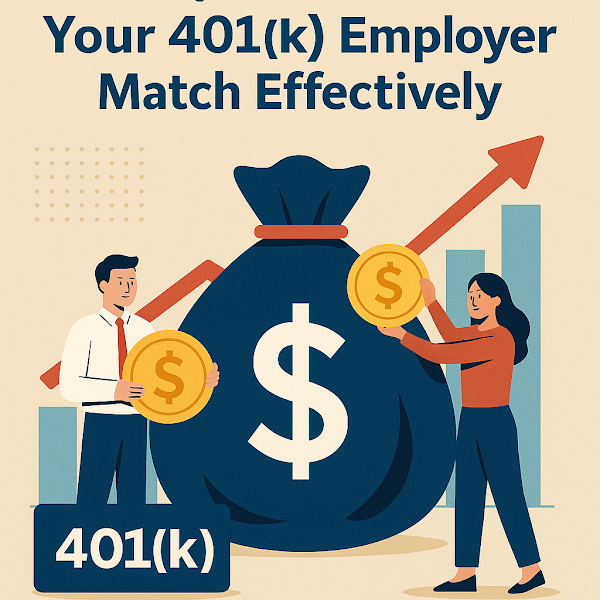How to Maximize Your 401(k) Employer Match Effectively
How to Maximize Your 401(k) Employer Match Effectively
Description: Don’t leave free money on the table! Discover how to make the most of your 401(k) employer match—understand matching formulas, vesting schedules, contribution limits, and smart strategies to boost your retirement savings fast.
1. What Is a 401(k) Employer Match?
A 401(k) employer match is when your company contributes money to your retirement account based on how much you contribute. It’s essentially “free money” that can significantly boost your long-term savings—if you take advantage of it correctly.
For example, if your employer offers a 100% match up to 5% of your salary and you make $60,000 a year, contributing 5% ($3,000) means your employer also puts in $3,000—doubling your savings. But if you contribute less, you’re leaving that match behind.
Shockingly, many employees miss out on this benefit by not contributing enough to receive the full match. Let’s make sure that’s not you.
2. Common Types of Matching Formulas
Employers use different matching structures. The most common include:
- Dollar-for-Dollar: Matches 100% of your contribution up to a limit (e.g., 100% of the first 4%).
- Partial Match: Matches 50% of your contributions up to a certain percentage (e.g., 50% of the first 6%).
- Tiers or Cliffs: Some plans offer stepped or delayed matches based on years of service.
Understanding your company’s specific formula is crucial. Check your benefits guide or talk to HR—you’d be surprised how many people don’t realize the exact match they qualify for.
3. How to Maximize Your Employer Match
Here’s how to ensure you get every dollar your employer is willing to give you:
- Contribute at Least the Full Match Percentage: If the match is 5%, aim to contribute at least 5% of your salary.
- Set Contributions Automatically: Automate payroll deductions so you never miss a match.
- Increase Contributions During Raises: Boost your 401(k) rate with every pay increase—you won’t miss the money if you never see it.
I once helped a colleague realize he was contributing just 3% when his employer matched 6%. That’s $1,800 of free money he was leaving behind each year. Don’t be that person!
4. Vesting Schedules: What You Really Own
Not all matched funds are immediately yours. Employers often apply a “vesting schedule” to their contributions. This means you earn ownership over time, usually through:
- Graded Vesting: You gain partial ownership each year (e.g., 20% per year over 5 years).
- Cliff Vesting: You get 100% ownership after a specific period (e.g., 3 years), or nothing if you leave early.
Always check your company’s vesting rules. Leaving a job too soon could mean forfeiting thousands in matched funds.
5. Avoiding Common Mistakes with 401(k) Contributions
Many workers unintentionally limit their 401(k) growth by making these mistakes:
- Not Contributing Enough: Failing to hit the match threshold means losing out on free retirement money.
- Front-Loading Contributions: Maxing out early in the year can cause you to miss match opportunities in later pay periods—some companies match per paycheck, not annually.
- Borrowing from Your 401(k}: Taking loans or early withdrawals can reduce growth and cost you in fees or taxes.
These are easily avoidable with proper planning. Double-check your contributions and match rules each January to stay on track.
6. Advanced Strategies for Supercharging Growth
If you're already getting your full match, here’s how to take your 401(k) to the next level:
- Increase Contributions Over Time: Aim to raise your savings rate 1% annually. Even small increases compound over decades.
- Consider Roth 401(k) Options: If your plan offers it, post-tax contributions could be beneficial if you expect higher retirement taxes.
- Max Out Annual Limits: In 2025, you can contribute up to $23,000 if you're under 50—or $30,500 if 50+.
- Use Catch-Up Contributions: If you're 50 or older, take advantage of extra contribution room to accelerate savings.
And always remember: consistency beats perfection. Whether you’re starting with 3% or 15%, the key is to contribute regularly and let compound growth do the heavy lifting.
According to Vanguard, the average employee leaves $1,336 in matching contributions unclaimed every year by not contributing enough. Over 30 years, that’s more than $80,000—without even factoring in investment growth. Matching contributions are one of the only guaranteed 100% returns in investing. Don’t just think of it as retirement money—think of it as a raise you can only access if you play the game right.
1. How do I know what my 401(k) match is?
Check your employee benefits guide, online HR portal, or ask your HR department directly. Every employer has a different policy and matching formula.
2. What happens if I leave my job before I’m fully vested?
You’ll only keep the vested portion of your employer’s contributions. Your own contributions are always 100% yours, regardless of tenure.
3. Can I change my 401(k) contribution amount later?
Yes. Most employers allow you to change your contribution rate at any time through your payroll system or HR portal. Adjustments are typically effective in the next pay cycle.
4. Is the employer match included in the IRS contribution limit?
No. The annual IRS limit applies only to your personal contributions. Employer matches are in addition to that limit and subject to a separate total plan cap.
5. Should I prioritize 401(k) match or paying off debt?
In most cases, it’s best to contribute enough to get the full match, then focus on paying down high-interest debt. The match is essentially a guaranteed return you don’t want to miss.



